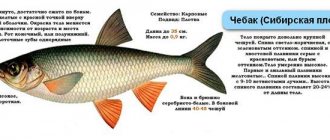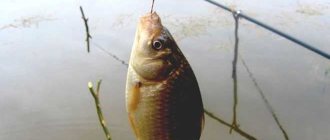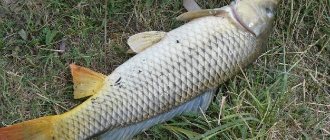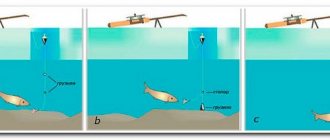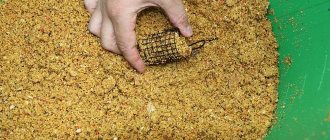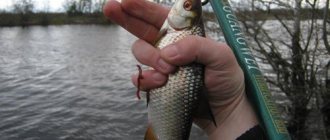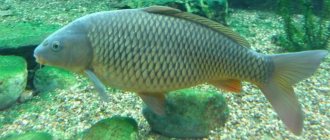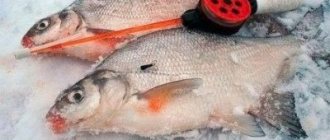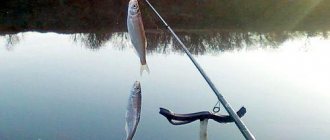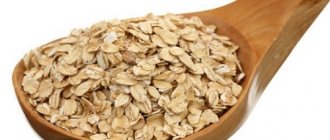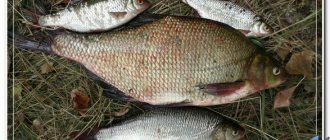Catching carp with a float rod is one of the most popular and effective ways to catch this fish. Fishing with a fishing rod begins in the spring, as soon as the water brightens and warms up above +10 ° C after the ice shell melts. Fishing ends in the fall when the water temperature drops to +10 °C. Mostly small carp take here.
It is best to catch carp using float tackle in the summer (July-August). The first bite begins at dawn. At this moment, large carp also bite. Small carp continue to bite until lunchtime.
The second bite is weaker, inconsistent and begins in the evening. A small fish takes the bait. But the most interesting thing is that the carp bite begins in all nearby reservoirs and rivers at the same time.
Float tackle for carp
There are several types of fishing rods you can use to catch carp:
- Fly rod. The simplest gear.
- Match fishing rod. They use a fishing rod of 4–6 m, complete with a spinning reel of 3,500–4,500 with a drag and a baitrunner. The main fishing line is monofilament Ø 0.3–0.35 mm, and a leash of 20–25 cm is narrower Ø 0.28–0.32 mm. A large float with a load capacity of 3–5 grams is used. and clearly visible from above. Its shape does not play any role. Hook number 3 is used.
- Plug. This short design allows you to hold light equipment at the casting point in any weather conditions. If the maximum size of the fish is assumed to be 1–2 kg, then any type of fishing rod (2.5–6 m) with any type of fishing line that corresponds to the breaking force of such a fish will do. For the leash, it is advisable to take blue or green fishing line.
When you expect to catch carp weighing 10–12 kg, then equip the line with a double forged hook No. 5–6.
Fly fishing rod
A fly rod is the simplest float tackle. The minimum length is 3 m, but can reach 11 m. When fishing for carp, as already mentioned, the maximum length is 6 m. The equipment should be of medium weight. In the case of natural material, the fishing rod is made from birch, juniper, rowan, walnut, bird cherry or elm.
Among fishing rods made from artificial materials, preference is given to fiberglass, carbon fiber or composite material. Experienced fishermen advise installing a connector at the end of the rod, which is selected depending on the diameter of the rod tip. If it is not possible to purchase a connection, then you can make it yourself from a piece of copper wire, which is wrapped with nylon thread.
It is not recommended to equip a fly fishing rod with a reel. The reel is used to store fishing line and is not used at all when fishing. The hook is selected so that the fish can swallow it completely. This is often #3.
The float is simple and made of lightweight materials. It stays on the line thanks to rubber cambrics. The shape of the float itself is selected depending on the fishing conditions. When selecting a float based on carrying capacity and weight, it is necessary to take into account the length of the rod: the longer the rod, the heavier the float. For example, when fishing at a depth of up to 1.5 m, take a float weighing 1.5–2 g. In windy weather and no greater depth - 3 g.
The main line is up to Ø 0.2 mm, and for the leash - Ø 0.12 mm, 10-20 cm long, buy flucarbon line. Although the casting distance depends on the weight of the weight, the principle is the following: the lighter the weight and the further they are attached to the equipment, the slower the tackle sinks to the bottom.
Match fishing rod
For a fishing rod, choose an ultralight rod with a length of 4 m or more, which is equipped with a reel with a friction brake. Most of the carp's jerks should be absorbed by the rod blank.
The reel kit (3,500–4,500) must have an additional spool. If it is missing, take another reel for additional fishing. A fishing line Ø 0.18–0.2 mm is wound on one spool to fish in open areas, with a bottom without snags, but for reservoirs with vegetation you will have to use a spool with a fishing line Ø 0.25–0.3 mm.
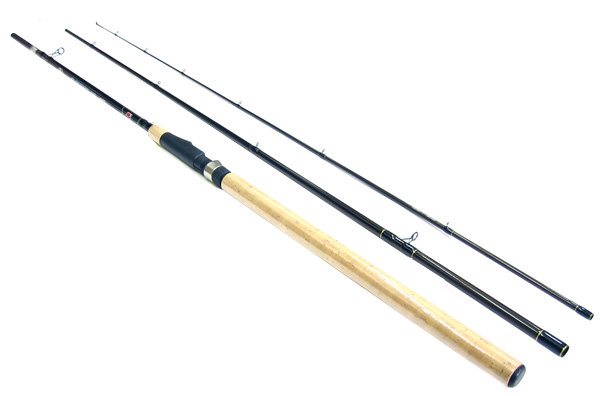
Accordingly, a set of leashes is also needed:
- Ø 0.12 mm and 10–20 cm long.
- Ø 0.16 mm and length 30 cm.
In shallow depths and light winds, cast the tackle 15–20 m from the shore. When the depth exceeds the length of the rod, use sliding equipment. In the opposite situation, blind equipment can also be used.
You can fish at greater depths, but for this you will have to take a heavier float.
Plug
You can catch carp with a plug rod even on the most unfavorable days. In this case, the length of the rod can reach 11–13 m. It is advisable to select plugs marked “carp”.
When catching carp up to 5 kg, a standard standard whale (the upper part of the rod) is suitable, and if there is a possibility of catching a larger individual, then a special “carp” whale will be required. To attach the plugs, shock absorbers made of special rubber Ø 1.6–2.0 mm are used.
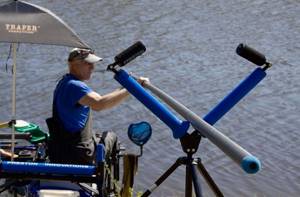
When fishing for fish weighing more than 7 kg, it is already necessary to use a shock absorber made of double-rolled rubber or use a double shock absorber. Although everything is relative here, you need to look at the characteristics of the rubber.
The choice of fishing line is more difficult here:
- A fishing line Ø 0.14 mm is used when catching fish weighing up to 4 kg. Hooks No. 2–4.
- Ø 0.18 mm already when catching 4–7 kg specimens. Hooks No. 5–6.
- Ø 0.20–0.21 mm is narrower for carp reaching 9–12 kg. Hooks No. 8–14.
Accordingly, a 3,500–4,500 reel with an additional spool is required. A sliding float is used in a drop-shaped form and no heavier than 1.5 g, with a center of gravity shifted to the keel with an antenna Ø 1.5 mm.
Two sinkers are installed on the fishing line. The first weight is attached 10–30 cm from the hook, the second at 30–60 cm. This weight is twice as heavy as the first. If necessary, the weights are moved together closer to the float (when fishing at a depth of 1 m) or not reaching the hook 20 cm. The most successful shape of the sinker is an olive.
Choosing float gear for carp depending on the weight of the fish:
- You can catch small and medium-sized carp with a fly and match fishing rod, and with proper fishing you can catch a 12 kg specimen without damaging the rod.
- The plug rod is more versatile; it allows you to cast the tackle over long distances; if necessary, by dismantling one section, you can shorten the length.
- When fishing from a boat, rods up to 2.8 m long are used. With this kind of fishing, even a beginner will find it difficult to break a fly rod if fished incorrectly.
- When catching large specimens, you need to take into account the size of the hook and bait.
For example, No. 7 is one grain of corn or peas. No. 10–14 – already two peas or corn grains.
Self-assembly of a fishing rod. Installation of the tackle begins with securing the fishing line to the rod. If a reel is used, then it is tied to it, and in the case of a simple fishing rod, then to the rod itself.
The color of the fishing line is determined taking into account the fishing conditions: among vegetation - green or yellow fishing line, steep bank - brown, etc. After passing the fishing line through the rings, a leash with a hook, weights and a float are attached to it.
Loading the float. The best floats for carp fishing are kug floats. You can also make a float from a goose feather. To have a sliding fastening in it, fishermen stick a pin with an eye in the lower part.
Loading methods. Nowadays you can purchase floats with constant or variable loading. It is better to choose a float whose lower part has a variable weight. This may be additional weight in the form of washers, or the float itself is equipped with a container for small shot. In addition to loading the float, a pellet weight of 0.2–0.4 g is attached near it, but still most of the load is distributed on the fishing line itself.
The float load is designed to correct the float immersion:
- In windy weather and waves. The body of the float should be barely visible above the surface.
- Calm and no waves. Only the antenna is visible.
Rod and reel
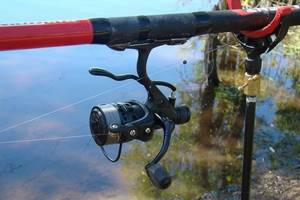
A carp fishing rod must have a high strength life in order to fight large prey. Also important for the blank is good flexibility and shock absorption, which will allow you to dampen the jerks of the fish, preventing it from breaking the line or falling off the hook.
We recommend reading: Catching pike perch using a balance beam in winter
The fishing rod for carp is telescopic, made of carbon fiber or composite material. Its length can be 4–7 meters. A short “rod” is easier to control and is useful when fishing near aquatic vegetation and in cramped conditions. In a spacious area, you can take a long model.
The reel in classic float tackle is used primarily for storing fishing line. It is better to choose a regular inertial model with sufficient capacity and safety margin. If an inertia-free gear is selected, then its size should be 2500–4000, the gear ratio should not be higher than 4.1:1.
Lure
- Complementary foods should be fragrant.
- The fractions of complementary food should be such that large pieces fit in the fish’s mouth.
- The complementary food itself should be dense and sink to the bottom.
- Bait is added to the complementary food, which will be used to catch fish. It can be crushed.
- Already at the fishing site, maggots are mixed into the prepared porridge and balls are rolled so that they crumble when they come into contact with water.
- When feeding, you need to take into account that the bait balls themselves do not scatter in the air, but also do not quickly become limp in the water.
- To do this, when rolling balls, clay from the shore is added to them.
- If it is not possible to throw them to the required distance, then they are shot from a slingshot.
- The timid fish hides from splashes on the water, but thanks to the smell, it begins to approach the complementary food in 10–20 minutes.
- For complementary feeding, cottage cheese, boiled potatoes, millet and pearl barley porridges, and various meal cakes (sunflower, hemp or flaxseed) are used.
- Complementary food is added 12 hours before fishing.

Here's a simple recipe:
- Boil 2 kg of pearl barley.
- Separately boil several potatoes in their jackets.
- Everything is mixed, a bottle of anise oil, two teaspoons of cocoa, 300 g of sunflower cake are added. If the cake is not fried, then it is fried.
- Additionally, several cloves of garlic are squeezed into the mixture.
Making your own bait:
- In summer, milk grains are used.
- Ripe raw corn is soaked until it sours. Then boil for one hour.
- You can also use canned corn and peas.
- Similarly, you can prepare complementary foods from peas, only they are soaked for 6–8 hours and steamed in a saucepan for 1–2 hours. After cooking, the peas are dried.
- Barley or millet is simply boiled.
- After preparing complementary foods, flavorings are added to it. These can be ready-made oils (anise, vanilla, strawberry, hemp, etc.), honey, cocoa (1 tablespoon per 1 kg of complementary foods), various fruits, chopped maggots, shelter, worms.
Bait for carp in spring
In spring, when the reservoir gets warmer, the carp begins to actively feed and look for food. After winter he is very hungry.
There are two ways to feed carp:
- The first method is to feed the carp at a specific point. That’s what it’s called – point feeding method.
The following can be used as bait: peas, corn, worms, maggots, and so on. There is no specific condition, feed with what you are going to fish with. It is necessary to throw such bait once every couple of minutes.However, care must be taken that this does not attract additional noise or rustling. This may scare away the fish.
- The second method is used to lure fish to a specific area. To do this, cook porridge or buy special bait.
The most popular are store-bought baits. They contain a very odorous mixture with large fractions. The components of baits for carp can be completely different. Balls are made from this bait and thrown into the water. It is important to throw in the same place to create the effect of spot bait.However, we recommend feeding the carp with plenty of complementary foods before you start fishing. This will help you not scare away the fish while fishing.
Bait
When going to catch carp using float tackle, you should stock up on various baits:
- In spring it is: bloodworms; worm; maggot.
- In summer: potatoes, dough, bread and its crust, pasta, corn, steamed and young peas, beans, beans, wheat, pearl barley, boilies, worms. The entire bait is saturated with the smells of strawberries, potatoes, sunflowers, vanilla, anise and cocoa.
- In autumn, plant and animal feed is needed. The bait is combined on the hook into a kind of sandwiches.
Baits and attachments for carp fishing
Among the baits, carp prefers:
- Undercooked new potatoes;
- Canned or boiled corn;
- Boiled peas;
- Millet;
- Bread crumb;
- Pea mastyrka;
- Steamed grains of rye or wheat;
- Semolina chatter;
- Boyles
In addition to baits, especially in spring and closer to autumn, carp also take the following baits:
- Maggot;
- Dung and earthworm;
- Bark beetle;
- Shitik;
Weather conditions for successful fishing
- The water temperature should not be lower than +14… +15 °C. Although, as already mentioned, carp begins to bite at temperatures above +10 °C.
- Carp take bait well during morning and evening dawn, as well as from 10 to 12 noon.
- It also bites at night when the moon is young. There will be a constant night bite only after the heat sets in and the water temperature reaches +20 °C. During the heat, carp hide during the day in the shade of reeds, in burrows and under snags.
- A stable bite begins after spawning.
- The main thing is that the weather is cloudy or cloudy, with a weak south or west wind.
- If there is a strong flood, you can try to catch this big fish in pools.
- Another sign of a good bite is the dropping of fish.
- 12–24 hours before bad weather, carp willingly take bait.
Bait for fishing with a float
Hi-pro Carp Geel (VDE) provides an excellent bait designed for northwestern waters. Our research gave good results - medium-sized fish were biting every 15-20 minutes. Simply empty the dry mixture into a container, add about a cup of water and mix together. For extra luring power we like to add corn or canned corn brine. There are also several commercial flavorings that can be added to give it an even stronger flavor, some of the most popular being strawberry, curry and caramel.
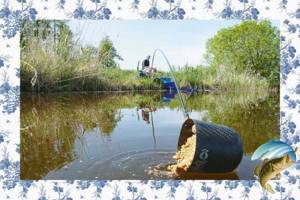
In rivers, it is best to use hard bait and throw it slightly upstream. This lures carp from long distances, as they will swim in the wake of the floating food left in the current. We usually start with a few good handfuls and feed constantly to actively keep the carp luring in. As the number of carp following the feed increases, you can sometimes stomach aggressive feeding as they compete greedily for food.
Deeper waters require a little more careful exploration as your bait needs to be fed into the area to intercept the big carp. Ideally, you should choose a location that has several snags. Otherwise you will lose most of your fish as the carp will get tangled in fallen trees and thick weeds if given the chance. Once you have chosen your spot, throw a few handfuls of bait in a comfortable range (9-10 meters). In general, don't feed too much until you see some activity. We usually feed bait after each fish, trying to avoid excessive splashing of bait, which will scare the fish away.
While the bait is doing its job of attracting the carp to your spot, it's time to assemble your float rod.
Nuances when fishing for carp using float tackle from a boat
- It’s easier to identify successful fishing spots from a boat thanks to a spinning rod or a marker rod.
- After choosing a place, make a test cast to find out the depth.
- Casting the tackle with a nozzle is done after feeding.
- When biting carp, the rod is held strictly vertically, sometimes giving slack in the line tension.
- Fish for a few minutes until it gets tired. It all depends on the endurance and ingenuity of the fisherman, since the carp tries to drag the fishing line under the snag, and it is also able to cut the fishing line with its upper fin.
Carp bite. The carp bites carefully, first tastes it, all this can be seen from the rocking of the float or from a slight movement to the side. If he has no suspicions, then he abruptly swallows the bait. When the float is weakly immersed, you can hook.
Sweeping. The hook is done slowly, pausing after the bite. If the carp greedily takes the bait and starts to leave, then the rod is lowered and fished out without hooking.
How to fish for carp correctly:
- When fishing for carp, you should not allow the fishing line to become slack for a long time.
- They fish not aggressively, they control the tension of the line using the clutch or the position of the rod relative to the surface of the water.
- It’s better to fish for carp for an extra few minutes than to break the rod and lose the trophy.
Features of carp fishing with float tackle depending on the time of year:
- In summer, shallow waters, fields, meadows, beaches, and sand and gravel quarries flooded after heavy rain are fished.
- In spring and autumn they fish mainly near snags, in the middle of a reservoir and river, where there are strong differences in the bottom level, and in the fall the fishing depth can reach 10 m.
- Don't forget about the pools in the spring.
Factors favorable for fishing
Knowing the favorable factors will help you be in the right place at the right time.
Let's point out the main signs that indicate that fishing today will be successful:
- Muddy water;
- Light southerly breeze;
- Low atmospheric pressure;
- Hot weather;
The best time to catch carp is before sunrise or after sunset.
Basically, carp fishing depends on the time of day and weather.
Let us point out the main fishing methods taking into account these factors:
- Floating bait should only be fished during the day;
- They catch fish with a loaded daughter early in the morning and in the evening;
- For a floating bait without using a float or sinker;
- In autumn, carp are caught only in the afternoon;
Unfavorable factors for carp fishing are:
- Change from clear conditions to cloudy weather;
- Long rains;
- High atmospheric pressure.
